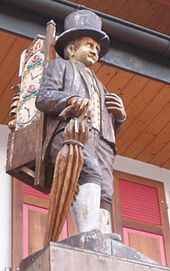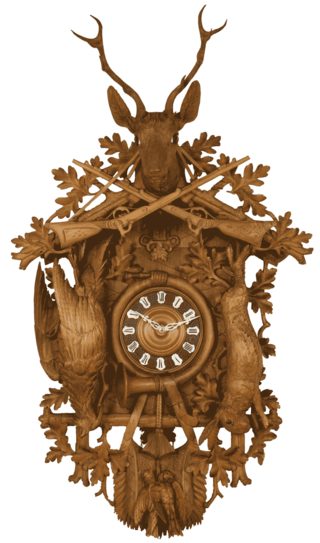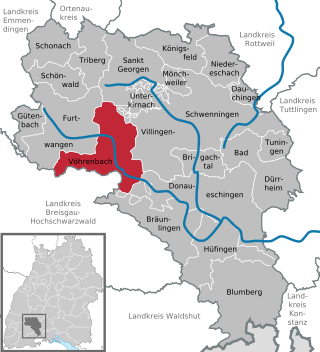
Craftsmanship of Black Forest clockmakers dates back to mid of the 17th century. A specialized branch of Black Forest clockmakers are the manufacturers of cuckoo clocks.

Craftsmanship of Black Forest clockmakers dates back to mid of the 17th century. A specialized branch of Black Forest clockmakers are the manufacturers of cuckoo clocks.
Black Forest clock production began in the mid-17th century. The first range of clocks were for practical use and of simple design. The popularity of clocks from Black Forest grew, and plates and clock faces became more sophisticated. It is said that, in the early days, Black Forest clocks were copied from the Bohemian style. [1] Gradually Black Forest clocks gained in reputation; especially the famous cuckoo clocks, which developed into their now typical style from around 1854.
In the first half of the 18th century, wooden wheels were used in Black Forest clock manufacturing (German : Holzräderuhr). In the second half of the 18th century, technical progress led to winding wheels being produced in yellow brass. Towards the end of the 18th century, plate clocks for the wall were produced. They had wooden panels which were painted in lacquer (Lack-Schilderuhr). At the end of the 18th century, Jacob Herbstreith manufactured small wall clocks with plates in porcelain or brass (Jockele-Uhr). At the beginning of the 19th century, the Sorgs, a clockmaker family, produced a very small wall clock (Sorg-Uhr). [2] [3]
The heart core of Black forest clock production was an area that extended from Triberg via Furtwangen to St. Peter. In 1850, the Duchy of Baden founded the first school for clockmakers in Furtwangen in order to improve the standard of production and make it more efficient. Several times of crisis followed. In the mid-19th century, mass production began. [4] But after the American Civil War, elements of the US war industry switched to highly competitive clock production. German clock manufacturers thus lost market share.
Special types of clock were developed: the cuckoo clock, the figurine clock, clocks that chimed the hours, the bracket clock and the grandfather clock. [5] [6]
At the beginning of the 20th century, the clock industry initially prospered but then collapsed as the First World War broke out and, subsequently, the Russian and American markets broke away. After the Second World War, exports boosted production.
In the 1970s, the advent of new plastic clock cases and quartz clockworks lead to serious restructuring. The new methods meant many workers became redundant and brought higher competition from the newly industrialized countries. Also, the introduction of LCD watches led to further painful restructuring. The number of employed clockworkers shrunk from 28,000 in 1973 to 21,000 in 1976. The export-oriented German clock industry had to weather a roller-coaster of unstable exchange rates, lower growth rates, high competition from developing countries and continual technological change.“ [7] Continuing new techniques and globalization affect the Black Forest clock industry.

The German Clock Museum (German : Deutsches Uhrenmuseum) also has in its collection some early Black Forest clocks with wooden cogwheels as well as a number of industrially produced Black Forest clocks. The German Clock Route (in German: Deutsche Uhrenstraße) is a themed route that connects places with relevant museums and (former) clock manufacturers in the Black Forest.
Bracket clocks and grandfather clocks by Black forest clockmakers are viewed on the German and American antique market as mechanical clocks of high craftsmenship. [8] [9]

A cuckoo clock is a type of clock, typically pendulum driven, that strikes the hours with a sound like a common cuckoo call and has an automated cuckoo bird that moves with each note. Some move their wings and open and close their beaks while leaning forwards, whereas others have only the bird's body leaning forward. The mechanism to produce the cuckoo call has been in use since the middle of the 18th century and has remained almost without variation.
Franz Anton Ketterer (1676–1749) was a German clockmaker.

A clockmaker is an artisan who makes and/or repairs clocks. Since almost all clocks are now factory-made, most modern clockmakers only repair clocks. Modern clockmakers may be employed by jewellers, antique shops, and places devoted strictly to repairing clocks and watches. Clockmakers must be able to read blueprints and instructions for numerous types of clocks and time pieces that vary from antique clocks to modern time pieces in order to fix and make clocks or watches. The trade requires fine motor coordination as clockmakers must frequently work on devices with small gears and fine machinery.

Furtwangen im Schwarzwald is a small city located in the Black Forest region of southwestern Germany. Together with Villingen-Schwenningen, Furtwangen is part of the district of Schwarzwald-Baar.

Robert Gerwig (1820–1885) was a German civil engineer.

Vöhrenbach is a town in the district of Schwarzwald-Baar, in Baden-Württemberg, Germany. It is situated on the river Breg, 12 km west of Villingen-Schwenningen.

The German Clock Museum is situated near the centre of the Black Forest town of Furtwangen im Schwarzwald (Germany), a historical centre of clockmaking. It features permanent and temporary exhibits on the history of timekeeping. The museum is part of the local technical college.

Gütenbach is a municipality in the district of Schwarzwald-Baar in Baden-Württemberg in Germany. It is the home of the Faller toy company.
The Dorf- und Uhrenmuseum Gütenbach is located in the village of Gütenbach, one of the historic centers of homebased manufacturing of clocks in the Black Forest region of Germany near the town of Furtwangen im Schwarzwald. It features primarily permanent and temporary exhibits on the local history of clockmaking, focussing on the history of making wooden clock movements. There also is a smaller general display on local history and rural living conditions in the 18th and 19th century.

Johann Baptist Beha was a prestigious Black Forest clockmaker born in Oberbränd (Eisenbach). He was trained by his father, the master clockmaker Vinzenz Beha (1764-1868), in his workshop where he built around 365 clocks between 1839 and 1845. At that time V. Beha was already known for the quality of his clocks, he made the so-called Shield cuckoo clocks.
Winterhalder and Hofmeier goes back to Winterhalder Uhrenfabrik in the Black Forest, a clock manufacturer from 1810. It was further manifested from 1850 under the new name Winterhalder & Hofmeier. In 1869 the company was renamed M. Winterhalder & Hofmeier, Friedenweiler und Schwaerzenbach, in Neustadt. From 1908 the new name was M. Winterhalder & Hofmeier GmbH. The company was part of the Black Forest clockmaker industry as its factory was located in Titisee-Neustadt and surroundings and as it subscribed to high quality standards. The company existed until 1933. It is regarded as one of the finest Victorian clockmakers of the time.

Emilian Wehrle (1832 – 1896, born in Schönenbach, was a reputed Black Forest clockmaker famous for his high-quality musical clocks. These musical clocks included the trumpeter clock, flute clock, singing bird clock, and rooster clock. These timepieces call the hour with the sound of a trumpeter, flute, bird and rooster respectively. He was also a maker of cuckoo clocks, but these were not the primary focus of the firm.
Theodor Ketterer was a renowned Black forest clockmaker who worked in Furtwangen, (Germany).

The Cuckooland Museum, previously known as the Cuckoo Clock Museum, is a museum that exhibits mainly cuckoo clocks, located in Tabley, Cheshire, England. The collection comprises 300 years of cuckoo clock-making history, since the very earliest examples made in the 18th to the 21st century.

The Black Forest Clock Association is a syndicate that was set up in 1987 to protect traditional mechanical cuckoo clock making in the Black Forest region in Baden-Württemberg (Germany).

The Black Forest Costume Museum is a museum in the convent building of the former Capuchin abbey in Haslach im Kinzigtal in the Baden-Württemberg county of Ortenaukreis in south Germany.

The German Clock Road or German Clock Route is a holiday route that runs from the Central Black Forest through the Southern Black Forest to the Baar region and thus links the centres of Black Forest clock manufacturing. It is about 320 kilometres (200 mi) long.